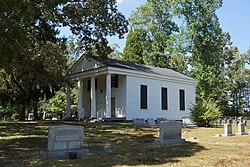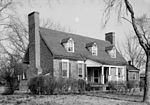Mount Stirling (Providence Forge, Virginia)
1851 establishments in VirginiaGreek Revival houses in VirginiaHouses completed in 1851Houses in Charles City County, VirginiaHouses on the National Register of Historic Places in Virginia ... and 3 more
National Register of Historic Places in Charles City County, VirginiaPlantation houses in VirginiaVirginia Peninsula Registered Historic Place stubs

Mount Stirling is a historic plantation house located at Providence Forge, Charles City County, Virginia. It was built in 1851, and is a 2+1⁄2-story, red brick, Greek Revival style plantation house. It features a small-scale Greek Ionic order portico and stepped gable parapets. Also on the property is a contributing altered kitchen building. The house sits among formally landscaped grounds undertaken in the 1940s. The plantation was the scene of significant activity during the American Civil War, as Union soldiers occupied the house in 1862 and again in 1864.It was added to the National Register of Historic Places in 1993.
Excerpt from the Wikipedia article Mount Stirling (Providence Forge, Virginia) (License: CC BY-SA 3.0, Authors, Images).Mount Stirling (Providence Forge, Virginia)
Courthouse Road,
Geographical coordinates (GPS) Address Nearby Places Show on map
Geographical coordinates (GPS)
| Latitude | Longitude |
|---|---|
| N 37.425555555556 ° | E -77.037222222222 ° |
Address
Courthouse Road
Courthouse Road
23147
Virginia, United States
Open on Google Maps





